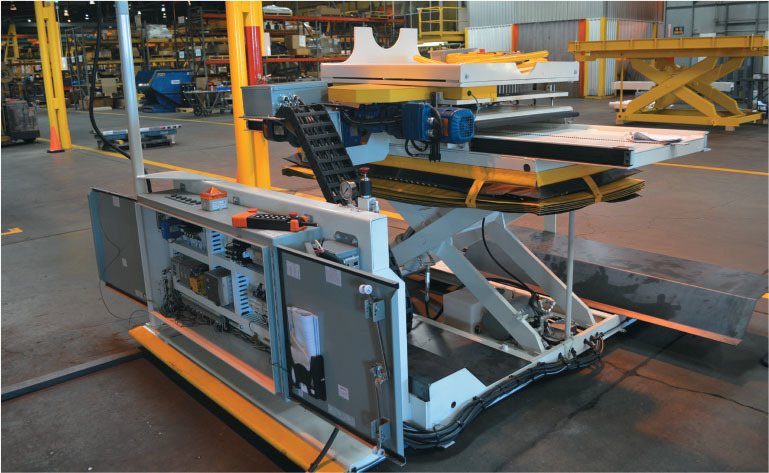 Back in the day, most lift tables, scissor lifts and tilters came with just a single control: a button or switch allowing the user to move the equipment up or down.
Back in the day, most lift tables, scissor lifts and tilters came with just a single control: a button or switch allowing the user to move the equipment up or down.
These days, however, manufacturers and distributors are demanding smarter lift equipment that integrates with other material-handling products to increase efficiency and reduce labor costs. Customers also want to maximize uptime by monitoring the status of their lift equipment, quickly diagnosing malfunctions and using data to predict failures.
“Going forward, lift tables need to have more advanced controls so they can talk, or as I say, ‘handshake,’ with robots,” said Stephen M. Graffam, senior product manager for MHI member Blue Giant Equipment Corp. “It’s forcing lift-table manufacturers to develop in-house control groups, which in decades past wasn’t even something being considered.”
Graffam serves as vice chair of MHI’s Lift Manufacturers Product Group (LIFT), which develops industry best practices, standards and information for equipment that lifts, rotates, tilts or otherwise positions materials. Examples include lift tables, scissor lifts, tilters, vertical reciprocating conveyors and pallet rotators.
Graffam will begin a two-year term as LIFT’s chair at the MHI Annual Conference in Fort Lauderdale, Fla., from October 1-4. He’ll succeed James Johnston, director of engineering for MHI member Autoquip Corp., who’s chaired the group for almost four years.
LIFT has six member companies—Autoquip, Blue Giant, Bishamon Industries Corp., 4Front Entrematic, Southworth International Group and Advance Lifts—and other lift-table manufacturers are encouraged to get involved, Graffam said. Over the years, LIFT has developed several important safety standards for the American National Standards Institute, including MH29.1, which applies to industrial scissor lifts, and MH29.2, for industrial tilters.
“When we as manufacturers follow those standards, our products have more credibility in the marketplace,” Graffam said. “Manufacturers that don’t meet those standards are unlikely to be many customers’ supplier of choice. Without LIFT, there wouldn’t be those industry standards.”
To illustrate how far lift equipment has come in the past decade, Johnston points to a customer’s warehouse that uses automated guided vehicles (AGVs) to store and retrieve products from racking. The racking has three levels, so AGVs need to use a lift table to access the upper two levels.
The lift tables, AGVs and warehouse management system are integrated, so when an AGV needs to access the second level of racking, the lift table automatically elevates it to that level, without the need for a worker to manually control it. The sophisticated controls boost efficiency and reduce the need for manpower, Johnston said.
Customers also want lift equipment featuring programmable logic controllers and human/machine interfaces such as touchscreens, Johnston said. When a lift table generates an error code, for example, a maintenance professional can access its touchscreen remotely to determine the issue and take corrective action.
If necessary, an offsite technician can take control of that touchscreen, similar to remote-desktop technology. That feature allows the technician to guide workers at the facility through the process of clearing up that error code, Johnston said.
Advanced lift equipment will enhance operations at manufacturing plants and warehouses in a number of ways. On an assembly line, for example, scissor lifts can be programmed to position material at the optimal level according to a worker’s height, improving ergonomics and reducing the rate of injury, Johnston said.
Each year, approximately 30% of workers’ compensation payouts are attributable to injuries resulting from poor manual material-handling practices, according to LIFT, so improving ergonomics is an essential component of workforce management. Scissor lifts and similar equipment help workers to eliminate unnecessary and repeated body movements, reducing the number of injuries related to strain and overuse.
Click here to read the full article.
PHOTO PROVIDED BY AUTOQUIP CORP.
 MHI Solutions Improving Supply Chain Performance
MHI Solutions Improving Supply Chain Performance